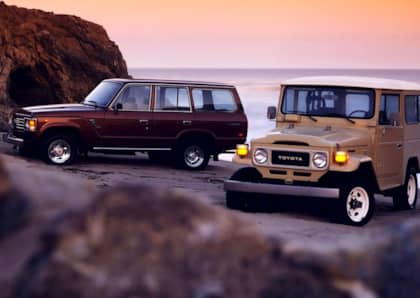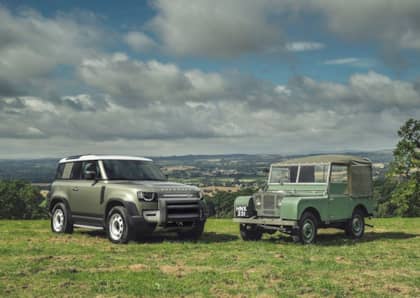The Land Rover Discovery Provides Cheap 4X4 Fun For Do-It-Yourself Mechanics
A quick visit to your favorite online classifieds site will quickly reveal that the first and second generation Land Rover Discovery is one of the cheapest classic 4x4s on the market. These venerable, capable, and stylish trucks occupy a very specific spot on the SUV landscape, respected and loved by their fans but also often avoided by those who've only heard horror stories about the need for frequent maintenance and repairs.

When it comes to the Discovery, there are definitely two sides to its character: the one that will get your through some of the toughest terrain you're likely to encounter on an off-road trail without any drama, and the one that could potentially bleed you dry if you're relying on a third-party mechanic or dealership to handle any inevitable issues for you.

If you're willing to turn a wrench yourself, however, both the Land Rover Discovery and the Discovery II present the chance to get behind the wheel of a rugged rig for not a lot of money.
Family Comes First
The Discovery was born after Land Rover's Range Rover line of SUVs had migrated towards a high end audience. Wanting a more accessible model to fill out its line-up, the Discovery was introduced in Europe as a family-oriented sport-utility in 1989 that featured some of the Range Rover's luxuries and almost all of its off-road acumen, but at a much lower price.

This family focus meant that the Discovery was also somewhat more practical than the Range Rover. Offered in both two-door and (eventually) four-door body styles, it was shorter and had a higher roofline, but the chassis and its full-time four-wheel drive system were borrowed from its pricier sibling. Where the Disco (as some of its fans would come to call it) cut corners was under the hood, offering a series of engines that were adequate, but not much more, during the daily drive.

The Discovery didn't reach American shores until 1994 (as a four-door model), and when it arrived it featured a familiar, 3.9L aluminum V8 as its only option, licensed from a '60s-era Buick design. Offering up a modest 182hp, this motor would be upgraded in 1996 to include a better engine management system and improved internals.

Compared to other SUVs of the day in the same class (such as the Toyota Land Cruiser), the Discovery stood apart with its massive greenhouse that treated second row riders to tall side windows and unique glass panels in the 'stepped' roof, providing a panoramic view of the rough terrain surrounding them. It also brought solid axles front and rear, along with very good approach and departure angles.

The exceptional wheel articulation of the Discovery's platform was not lost on 4x4 fans, and with its center-locking differential, long-travel suspension, and the availability of a five-speed manual gearbox alongside its four-speed automatic, it was a versatile tool for those willing to take a chance on a new off-road player.
Evolving The Concept
The Discovery II, which arrived in 1999, added a third row of seating to the mix, as well as a longer and wider body that plumped up the creature comforts to smooth out the commute.

Visually, the updated Discovery II didn't make too many waves, but Land Rover claimed it was almost entirely new under the skin. Key changes (aside from all-new body panels) included a wider track as well as a revised suspension setup intended to improve on-road handling. Things also started to get a bit complicated from a systems perspective, with the introduction of an optional 'active cornering enhancement' system that used hydraulic actuators in place of traditional anti-sway bars, a hill descent control system, four-wheel traction control, and as air springs at the rear that could raise and lower for extra ground clearance.

Many of these systems were derived from BMW, which had purchased the brand a few years beforehand. The Buick engine was kept in place but a new set of Bosch controls gave it a little more grunt, with 251 lb-ft of torque represent an increase of 18 over the older model and giving it overall quicker performance in a straight line. The Discovery II remained on sale until 2003 when it was replaced by the LR3.
Due Diligence Required
Tough and tenacious it might be, but the Land Rover Discovery could also cost you more than its asking price when it comes to taking care of its weak spots. Fortunately, if you're not afraid to work on the truck yourself, and are willing to do a pre-purchase inspection, you can handle most of what the Discovery I and Discovery II will throw your way.

First and foremost are the head gaskets on the Buick-sourced V8. It's very common to encounter a cheap Discovery that is overheating, and this is often linked to a leaking head gasket on the 3.9L and 4.0L engines. A professional will charge between $2,000 and $3,000 to repair this. If you want to do it yourself, the process is time consuming but not difficult, and the parts you'll need will cost you a third of that. It's well worth inspecting the condition of the radiator and water pump at the same time.

The Discovery often rusts around the inside of the fenders and the underside of the cargo area at the rear. Also check for leaks from the steering box. Finally, you're going to inevitably encounter problems with window switches, sunroof motors, seat motors, wheel bearings, the front driveshaft, and rubber bushings. Keep parts on hand during your ownership, and replace any components that look worn before they either strand you or soak you.

With that advice in mind—and by respecting the religious fluid change intervals required for any long-term Land Rover ownership—the Land Rover Discovery I and II are cheap portals into off-roading that haven't yet caught on with collectors, making them unusual and fun drives for do-it-yourself mechanics and engaged owners alike.











